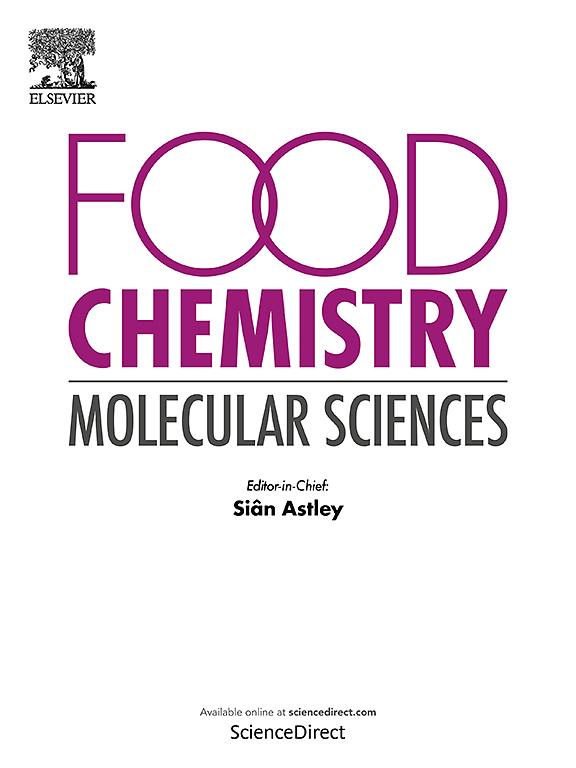采收前用赤霉素(GA3)和一氧化氮供体(SNP)处理可提高葡萄果实采收后的硬度。
IF 4.1
Q2 FOOD SCIENCE & TECHNOLOGY
引用次数: 0
摘要
葡萄容易软化,这限制了它们的保质期和长途运输的适用性。本研究探讨了化学防腐剂赤霉素(GA3)和一氧化氮供体硝普钠(SNP)对葡萄硬度影响的分子机制。提高葡萄品质,延长保质期,扩大市场供应是主要目标。通过转录组学和理化分析,研究发现,3 mmol/L GA3和20 μmol/L SNP处理显著提高了“银红”葡萄的硬度,从而提高了整体品质。然而,两种治疗方法的作用机制不同。GA3抑制果胶降解,促进纤维素积累,而SNP通过调节细胞壁代谢促进木质素和纤维素积累。此外,转录因子如CYPs、NAC043和WRKY33被确定为与靶基因协同作用影响浆果硬度的关键调节因子。这些发现强调了GA3和SNP在提高葡萄品质和延长贮藏潜力方面的关键作用。本文章由计算机程序翻译,如有差异,请以英文原文为准。
Pre-harvest treatment with gibberellin (GA3) and nitric oxide donor (SNP) enhances post-harvest firmness of grape berries
Grapes are prone to softening, which limits their shelf life and suitability for long-distance transport. This study explored the molecular mechanisms underlying the effects of the chemical preservatives gibberellin (GA3) and the nitric oxide donor sodium nitroprusside (SNP) on grape firmness. Enhancing grape quality, prolonging shelf life, and extending market supply were key objectives. Using transcriptomic and physicochemical analyses, the study found that treatments with 3 mmol/L GA3 and 20 μmol/L SNP significantly increased the firmness of ‘Yinhong’ grapes, thereby improving overall quality. The mechanisms of action, however, differed between the two treatments. GA3 inhibited pectin degradation and promoted cellulose accumulation, whereas SNP enhanced lignin and cellulose accumulation, by modulating cell wall metabolism. Furthermore, transcription factors such as CYPs, NAC043, and WRKY33 were identified as key regulators working in concert with target genes to influence berry firmness. These findings highlight the critical roles of GA3 and SNP in improving grape quality and extending storage potential.
求助全文
通过发布文献求助,成功后即可免费获取论文全文。
去求助
来源期刊

Food Chemistry Molecular Sciences
Agricultural and Biological Sciences-Food Science
CiteScore
6.00
自引率
0.00%
发文量
83
审稿时长
82 days
期刊介绍:
Food Chemistry: Molecular Sciences is one of three companion journals to the highly respected Food Chemistry.
Food Chemistry: Molecular Sciences is an open access journal publishing research advancing the theory and practice of molecular sciences of foods.
The types of articles considered are original research articles, analytical methods, comprehensive reviews and commentaries.
Topics include:
Molecular sciences relating to major and minor components of food (nutrients and bioactives) and their physiological, sensory, flavour, and microbiological aspects; data must be sufficient to demonstrate relevance to foods and as consumed by humans
Changes in molecular composition or structure in foods occurring or induced during growth, distribution and processing (industrial or domestic) or as a result of human metabolism
Quality, safety, authenticity and traceability of foods and packaging materials
Valorisation of food waste arising from processing and exploitation of by-products
Molecular sciences of additives, contaminants including agro-chemicals, together with their metabolism, food fate and benefit: risk to human health
Novel analytical and computational (bioinformatics) methods related to foods as consumed, nutrients and bioactives, sensory, metabolic fate, and origins of foods. Articles must be concerned with new or novel methods or novel uses and must be applied to real-world samples to demonstrate robustness. Those dealing with significant improvements to existing methods or foods and commodities from different regions, and re-use of existing data will be considered, provided authors can establish sufficient originality.
 求助内容:
求助内容: 应助结果提醒方式:
应助结果提醒方式:


